Points of Interest
Awards for the building | UIA Auguste Perret Prize (1969)
Building of the century (2000)
Interior design of the hotel and restaurant | Otakar Binar
Static engineers | Zdeněk Patrman, Zdeněk Zachař
Building construction | Josef Patrman a Václav Bůžek
Quantity surveyor | Jaroslav Koucký
Electro-installation | Slávek Zrůst
Air conditioning and heating | Otta Valouch
Diameter of foundations | 33m
Foundation stone laid 30. 7. 1966
Investor | Správa radiokomunikací, Praha
Total cost | 64 000 000 Kčs v roce 1973
General supplier | Pozemní stavby, Liberec
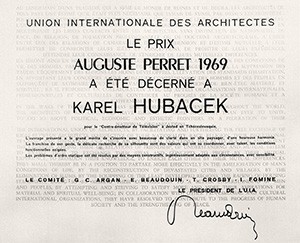
Ingstav Pardubice | concrete pillar
Vítkovické železárny | steel construction
Glaverbel | Jested glazing (originally Stopray Gold insulating double-glazing, at present Stopray Silver 43/25 6 mm -10- Planibel clear 6 mm insulating double-glazing
Zukov Praha | aluminium surface coating
Rudné doly Ejpovice | fibreglass sheeting covering the antenna
Angling federation | 11m long structural rods for securing fibreglass sheets
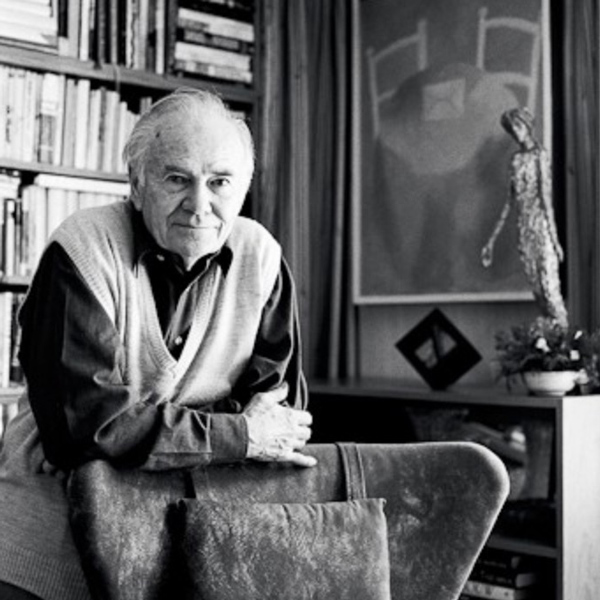
Karel Hubáček, doc. Ing. arch., Dr.h.c
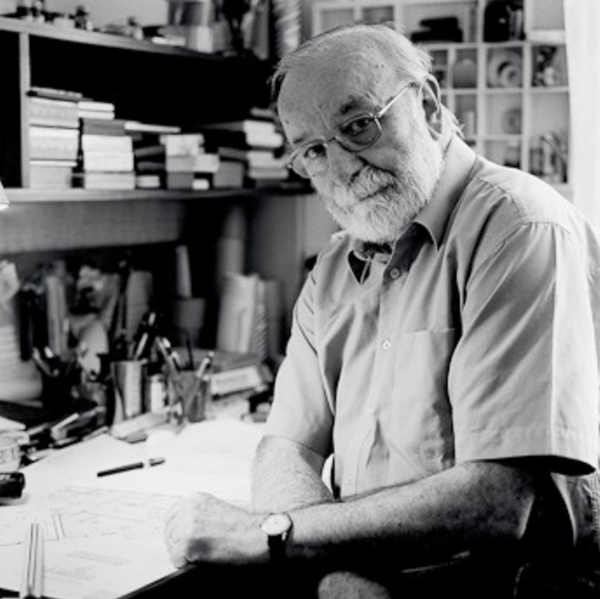
Otakar Binar, akad. arch.
PENDULUM
Oscillating in the wind
Soon after completing the steel construction of the tower, and mounting the laminate extension, it was noticed that the slim section oscillated at troubling amplitudes during periods of continuous, but not strong winds. The phenomenon of oscillation of a cylindrical body in a stream of air or water is connected to the mechanism of its circumfluence: under certain conditions vortices break off alternately from both sides of the cylinder, which extrapolate into a regularly formidable force which, with supple and relatively undamped systems have resonant effects which oscillate the structure. This phenomenon has been known for more than 100 years, and in the mid twentieth century after a huge expansion in welding it became abundantly apparent in pipe and cylindrical constructions, such as steel chimneys, bridge supports and masts. The oscillation which occurred was not objectively measured, but a frequency of 50 oscillations per minute was observed, and an amplitude of 20 cm estimated. The tensions thus created were not in themselves dangerous to the construction, nevertheless the unnerving psychological effect on the viewer, uncertainty in the expected frequency of the repetition of the phenomenon, the risk of disturbing the broadcast signal, and misgivings about material fatigue compelled the architects to exclude this oscillation in future. And thus it happened that soon after this trouble, Ing Patrman appeared at my door, and another chapter opened in the technical history of the Jested transmission tower.
Special pendulum to eliminatethe cause of oscillation in the tower
Oscillation of the type found on Ještěd had already appeared on transmission masts and first generation towers since the late 1950’s (Buková mountain, Suchá mountain near Kremnice), and there was a certain amount of experience of these problems (Ing. Dr Jiří Kozák, CSc., 1922–2003, Vítkovické steel works, Bratislava and Prof. Ing. Miloš Novák, Ph.D., 1925–1994, Kloknerův ústav ČVUT, since 1967 University London, Canada). At that time the oscillation was corrected with short, vertical ribs of a width of approx. 1/10 that of the cylinder, welded to the shaft spirally – thus altering the aerodynamic effect, and preventing the creation of regular eddies which led to oscillation. This method, but with a connected spiral, is still used on steel chimneys. Disturbing the appearance, while not important in a building standing at a distance from civilization, would not, however, be acceptable for such an exposed building as the Ještěd transmission tower. There remained a solution involving changing the very dynamic effect of the construction – a dynamic damper (or rather absorber) to reduce the oscillation. The principle has been known since at least the first half of the C20th: this consists of connecting other material to the construction such that, given specific stimulation, this attached material oscillates, and the original material, ie the construction itself, remains still, as far as possible. Everything can be calculated and optimized, the problem remains to design equipment such that it can be installed in the specific building, and that it can be made, and fitted. Thus far in Czechoslovakia there had been no experience of this, however it was known that such equipment was either being considered, or was in fact in operation in certain towers in Germany (Dresden, Berlin). The only problem was, therefore, to find the most suitable way to build it, such that it would fit into the available space, such that it can be assembled in situ from transportable parts, and if possible such that it’s mass can be kept exact, or even be adjusted, the frequency of the oscillations and the damping effect, as the absorbing effect is dependent on these quantities. From our consideration of a cylindrical extension, the damper would have a frame in the shape of a ring (with a possible access hole in the cylinder lid on the top of the tower) and with the pertinent number of added weights. This ring is supported by four slings, of a length set by the required frequency of oscillation, with automobile shock absorbers propped at an angle of 30 degrees to the vertical to the steel lid from which it hangs. The shock absorbers were adapted by the manufacturer (Autobrzdy Jablonec) such that they would spread their damping force in proportion to their number. Finding specialists for the detailed design, construction and supply of these parts, within a reasonable timeframe was, given the conditions prevailing at the time, a superhuman task; nevertheless Ing. Patrman managed to do so. After the Jested damping mechanism, others followed as the number of small and large transmission towers grew, complete with antennae in laminated cylinders, to accommodate the second television channel. The transmission tower at Cukrák was also saved in this way when, in 1972, and after 10 years of service, it was in need of replacement due to anxieties over fatigue defects during its expected oscillation. Rather than replace the tower, it was sufficient to rebuild it with new antennae in accordance with designs by Ing. Fr. Šímáček from Spojprojekt, Prague, and this was carried out from 1974–1975. The same principle of absorbing oscillation in simple construction arrangements was used many times in the case of steel chimneys by Doc. Ing. Viktor Kanický, CSc (*1982) from the Brno Military academy. It is also used on narrow foot bridges, and on tall buildings abroad. From time to time various problems, as well as ways of improving and simplifying the construction, were encountered with the equipment, nevertheless the damped pendulum is still operating today, thanks to those early operations on Jested.
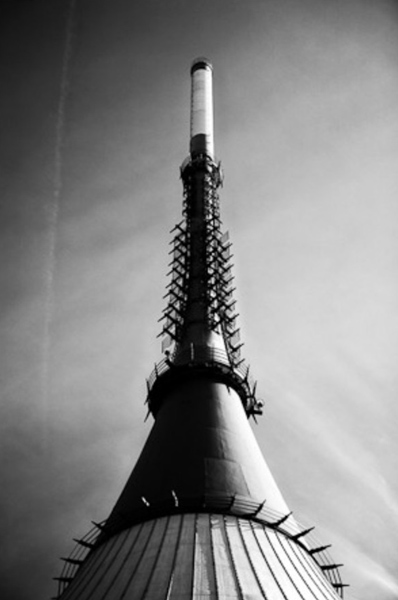
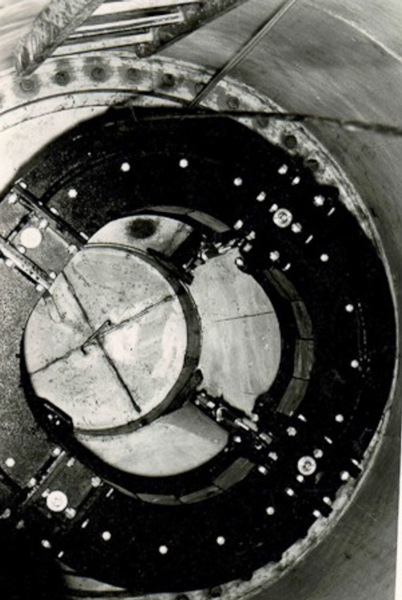
Dynamic testing of the tower
The pendulum absorbing the oscillation is sensitive equipment which requires tuning, e.g. the relation between its own frequency and that of the construction itself, and the correct degree of damping. All these quantities can be (and in the case of Jested, were) calculated in the design phase, from the point of view of long-term expected effectiveness of the shock absorbers, however it was necessary to verify these in practice. Therefore, at least at the start, and above all as this was the first time such a system had been used, the behaviour of the structure was verified after installation on the Jested tower. In particular this meant ascertaining its own actual frequency and the damping of the tower without the pendulum, or by blocking the pendulum (for example with wedges to prevent the movement of its mass), and then with the damping system functioning. To carry out these measurements the creators of Jested managed to engage one of the then best equipped, both technically and as regards personnel, specialists, the above mentioned Prof. Křupka from the Military academy in Brno.
The experimental verification of the oscillation on the finished structure was far from simple, even for a specialist institution. In contrast with regular measuring, undertaken in a laboratory or on an accessible building where movements can be extrapolated to a fixed point, here no such extrapolation was possible due to the height and location of the building. The movement in the construction must be measured with respect to another mass incumbent in the structure to be measured, but it must be attached to the construction very gently, with a frequency of its own less than that of the construction being measured (the so called seismic mass, the principle of the seismograph). Bearing in mind that the basic true frequency observed for the Ještěd tower was 0.613 Hz, therefore if the seismic mass should have a frequency of half this (0.306 Hz), and was to be implemented by a pendulum, this would have to have a pivot height of 2.65 m, which would not be feasible for the measuring equipment. Another way of measuring the amplitude is a circuitous method using a voltage resistance tensiometer, or through accelerated and double integrals; this is possible but with low frequencies there is the spectre of the requirement of a sensitive accelerometer and exact integrals. The second problem was the excitation of the pendulum to be measured. We don’t know the inducing impulse caused by the wind alone; mechanical eccentric rotational exciters are good, but with low frequencies, as are found in the tower, the inducing force (the centrifugal force of the rotating, imbalanced mass) is very low. Oscillation can be induced by human intervention, the movement of one or more people to the right rhythm; however this doesn’t work in the case of a tower with functional damping, as a result of the absorption.
Fully aware of these difficulties three measurements were taken throughout the autumn of 1970 and the winter of 1971, both before and after the tower was fitted with the absorber. Movement was registered both by tensiometer on the steel construction and on the laminate, and then the tensiometer was moved opposite the seismic mass at the level where the steel construction finishes. A cable was fixed at the level of the top of the steel structure, and tensioned, at an angle to the ground of 30 degrees, to a manual winch on the ground. The cable was tightened to a force of 54.8 kN, before being cut, such that the tower oscillated, damped by its own structure. In this way its natural frequency and damping were ascertained. With the cable thus tensioned, the peak of the tower was moved by 117 mm, measured by theodolite from the ground. The measurement was arranged and conducted by Doc. Kanický and Ing. Hubert Bukač (*1935, since 1984 resident in the USA) and colleagues.
Oscillation using a tensioned cable works and reflects the mechanical effects, nevertheless it is both labour intensive and time consuming. The last of the three measurements on the Jested tower, which involved rocket motors, was taken in co-operation with the same external workplace as earlier, the military academy in Brno.
Col. Ing. Bedřich Růžička enthusiastically joined the project, and adapted components from construction parts at his disposal to form a solid fuel rocket motor which was easily transportable, ready to use, safe and reusable. This, when ignited electrically produced an impulse curve of an almost perfectly rectangular shape (in this case) of 11 kN for a period of 0.9 s. This proved to be a very suitable method of inducing oscillation for dynamic testing and has since been used not only on towers, but on bridges, tall buildings as well as cooling towers and frame foundations of turbo generators in power stations. This is the last of the technical innovations devised and implemented by those who crated the Jested tower which have since been used elsewhere than on this tower.
We are commemorating work which took place approximately 40 years ago, thus under completely different technical, economic and political conditions than today, and science itself has progressed a great deal since then. Many of the problems discussed here, and the complex solutions they demanded then, do not present problems today; plastics are used as a matter of course in all areas of building and machine engineering. The experimental determination of the natural oscillation frequency of constructions is achieved with much more advanced scanners and evaluating apparatus, and often do not require excitation – sensitive scanners can capture the response of a structure during normal periods of seismic disturbance caused by road or other traffic in the area, and analyzers at the end of measuring lines draw graphs of, or enter the spectrum of results directly into a computer, thus giving the unique frequency of the structure and its damping. Specialist companies design and install dynamic absorbers on bridges and in tall buildings to reduce oscillation caused by wind or earthquakes, often these are active absorbers which independently react to movement caused, and correct their parameters or their movement such that the protected construction is pacified. And the antennae themselves? The question remains how long modern systems for the transmission of electromagnetic waves will require towers such as the Ještěd mountain hotel. With communication satellites, cable, small antennae on the roofs of houses or low towers creating a connected network and carrying innumerable telephone calls and radio stations – will anyone still need 300 m masts and towers, proudly planted in the second half of the Twentieth century?
Prof. Ing. Ondřej Fischer, DrSc.,
The Institution for Theoretical and Applied Mechanics, Czech academy of sciences.
(From the article “More about Jested”.)